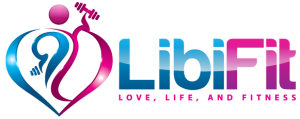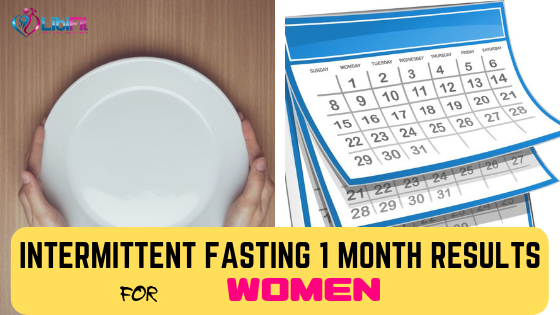Intermittent fasting results 1 month female outcomes are constantly searched for. Here at Libifit we have just what you are looking for if you are interested in intermittent fasting results after 1 month. We have gathered data from 12 different women who been committed to following an intermittent fasting protocol for at least 1 month. These same women were given a copy of our Intermittent Fasting for Women 60-day journal to use to help them on their weight loss journey.

This article will detail the progress of these women 1 month after they started intermittent fasting. All of the women had goals to
lose weight, improve their overall energy levels, and experience all of the health benefits of intermittent fasting.
Intermittent Fasting Brief Overview
Before we get into the intermittent fasting results 1 month female outcomes, let’s briefly discuss intermittent fasting.
Intermittent fasting has been trending in recent years due to the numerous health benefits it promises. This dieting method is claimed to improve metabolic health, induce weight loss, burn body fat, and extend the lifespan of people following it.
Given the growing popularity of intermittent fasting, different methods have been developed to make it as convenient and sustainable as possible. While all the methods can be effective, the one which fits the best varies according to the individual.
What is intermittent fasting and what are different ways of doing it? Are there any side effects of fasting for such a long time? This article will provide in-depth answers.
Also, we will examine the intermittent fasting results 1 month female outcomes mentioned previously.
What is Intermittent Fasting?
Intermittent fasting refers to a type of eating pattern that alternates between periods of eating and fasting. There are no specific restrictions regarding which foods to eat and which ones to avoid.
Human beings have been fasting throughout the entire process of evolution. The ancient hunter-gatherers had no means of storing food and often had to starve themselves due to unavailability of food. As a result, humans gradually developed an ability to be able to function for extended periods of time without food.
Fasting is, in fact, considered a more natural process than eating every 3 to 4 meals per day. In some religions, fasting is also adopted for spiritual reasons which put more emphasis on its benefits on human health.
There are different types of intermittent fasting the most popular of which have been described below in detail.
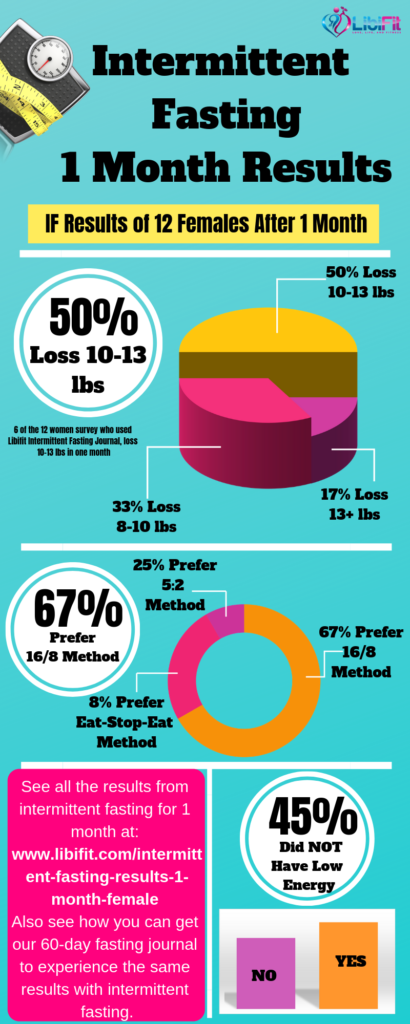
Intermittent Fasting Results 1 Month Female Summary
We gave 15 women a free copy of our Intermittent Fasting for Women 60-day journal to use for a 1 month study on intermittent fasting.
The women were also given our Intermittent fasting or women ebook. We supplied the women with the fasting journal because research shows that people who use diet journals lose twice as much weight as those who do not. We believed the woman would experience more success using the intermittent fasting journal.
Intermittent Fasting Results 1 Month Female: Pounds Lost
After one month, of the 15 women we provided the journal and ebook to, 12 of them successfully maintained their intermittent fasting diet and sent in the intermittent fasting results for 1 month.
We asked the women a variety of questions ranging from the amount of weight they loss to their levels of energy at various time during their first month of fasting. Below are the all of the intermittent fasting results 1 month female outcomes.
The 12 women who practiced intermittent fasting for one month lost an average of 10.33 lbs. with the highest weight loss being 14 lbs and the lowest 8 lbs.
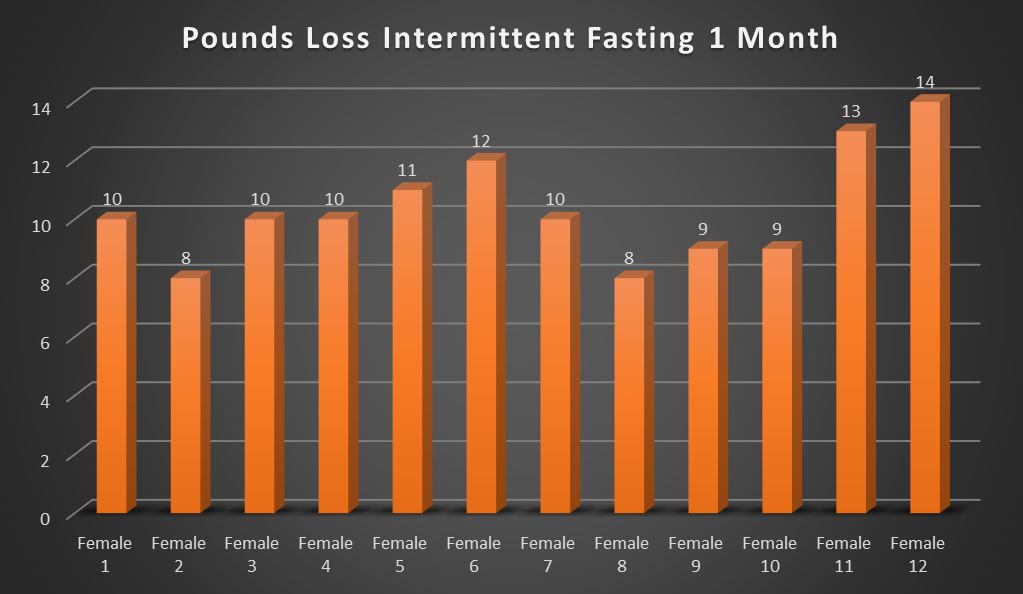
Intermittent Fasting Results 1 Month Female: Preferred Fasting Method
16/8 Fasting Method
This type of fasting method is particularly popular among the masses as it is the easiest and easily fits the schedule of most people. The 16/8 method includes fasting for 16 hours a day followed by an eating window of 8 hours.
A lot of people who started intermittent fasting and fasted for 16 hours straight swear by its weight loss effects on their body.
The 16/8 method is a great way to lose weight, especially for people who usually like skipping breakfast. You can easily follow this diet by having your last meal of the day at 7 pm and fasting for 1 pm the next day.
This way, you will spend most of your fasting period in sleep and won’t get affected by cravings and hunger pangs at all. The only drawback of this method is for people who usually like to eat breakfast before going to work. It may also be problematic for people to go to the gym early in the morning as working out on an empty stomach can be difficult.
Some health experts suggest that women should not try out this method since their bodies are more prone to getting damaged due to prolonged fasting. However, remember that everyone has a different body and to know what suits you best, you would have to try it out for yourself.
5:2 Fasting Method
The 5:2 method is a hardcore method that includes fasting for 24 hours straight. However, some people consider it easy as you only need to fast twice a week and resume eating normally during the rest of the days.
During the 2 designated days of fasting, you have two options. You can either stop eating completely or restrict your calorie intake to 500-600 by eating healthy foods only
You also have an option to fast for 24 hours on two non-consecutive days or go for a 48-hour fast once a week. The latter is usually discouraged as experts consider it too harsh for the body.The 5:2 method may sound more extreme but is equally effective for fat burning.
Eat-Stop-Eat Fasting Method
This particular type of intermittent fasting comprises of a full 24-hour fast. This means that for 24 hours straight, you will consume nothing but water. You may also consider drinking calorie-free beverages like coffee.
The time frame in case of the eat-stop-eat method is completely up to you. You may begin Monday night after having dinner, fast for the next 24 hours and enjoy the dinner the very next day.
Because you are not allowed to take in any calories during this time, the stop-eat-stop method is very powerful at burning the fat stores in your body. It is also a great way to get into ketosis faster than usual.
If you are new to intermittent fasting, it is recommended to try the moderate fasting methods before switching to this hardcore type. Starting with crescendo fasting is a great approach to fasting for women.
Read about crescendo fasting now by clicking on the article link.
The women in the study utilized the three different methods discussed above. Of the fasting methods utilized, the 16/8 method was the most popular. Sixty-seven percent of women used this method. Also, while it is not detailed in the data presented, many women said they begin their fasting journey using the crescendo fasting method for about one week.
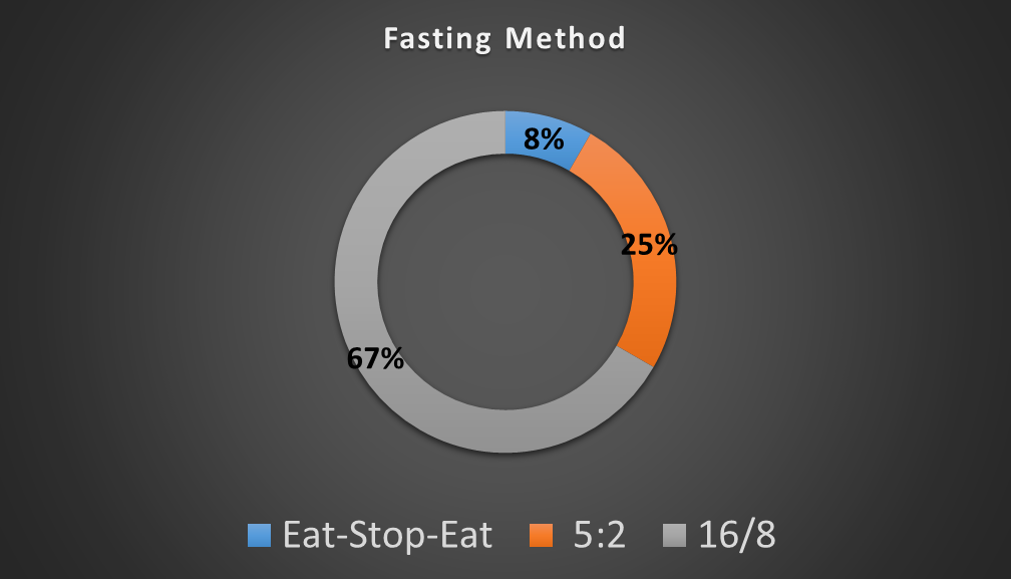
Side Effects of Intermittent Fasting
While intermittent fasting is generally safe for all people, it has been associated with certain risks and side effects. It is suggested to talk to a physician before trying this diet, especially if you already suffer from health complications or problems. Below are some of the most common side effects encountered during intermittent fasting.
Headaches
As your body is still adjusting to the new eating pattern, it is common to feel dull headaches. Dehydration is considered as one of the main reasons behind it. So make sure you drink lots of water both during the fasting and eating phases.
Another reason why these headaches occur changes in the sugar and insulin levels in the body. These changes occur due to the stress hormone released in your body during fasting.
In our intermittent fasting results 1 month female outcomes, we have data on how the 12 women who participated in this study experienced headaches. See the results below.
Intermittent Fasting Results 1 Month Female: Headaches
As mentioned above headaches are known to be a side effect of fasting, especially at the beginning. We asked the women about their whether or not they experienced headaches after the first week and 83% of them said they did not experience headaches after the first week of fasting.
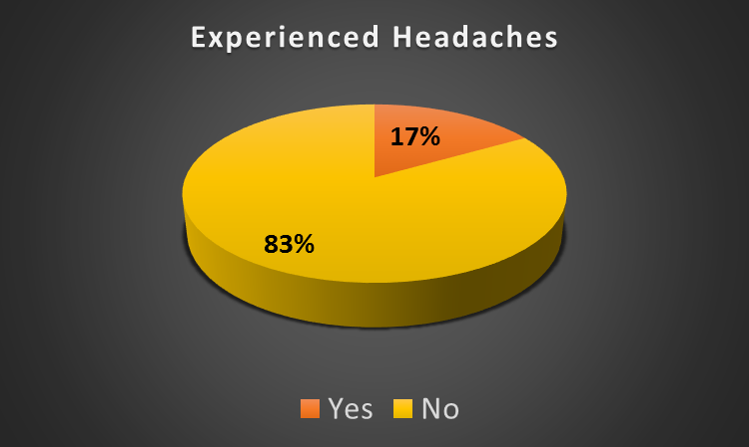
Intermittent Fasting Results 1 Month Female: Energy Levels
Of the women who responded to our survey after using the intermittent fasting journal, 55% said they experienced low energy in the first week. However by the second week, only 10% continued to have low energy. This could be due to several factors which may or may not include the fasting protocol. Most of the women who did continue to experience low energy after the first week were those who primarily followed the eat-stop-eat method.
Low Energy
During intermittent fasting, your body is not getting the constant supply of fuel as it used to get previously. So a drop in your energy levels is quite common, especially during the first few days.
Try keeping your schedule as relaxed as possible to lower your energy needs. You may also think about putting your workout schedule on hold until your body adapts to this new diet. Low energy is another side effect assessed in our intermittent fasting results 1 month female outcomes.
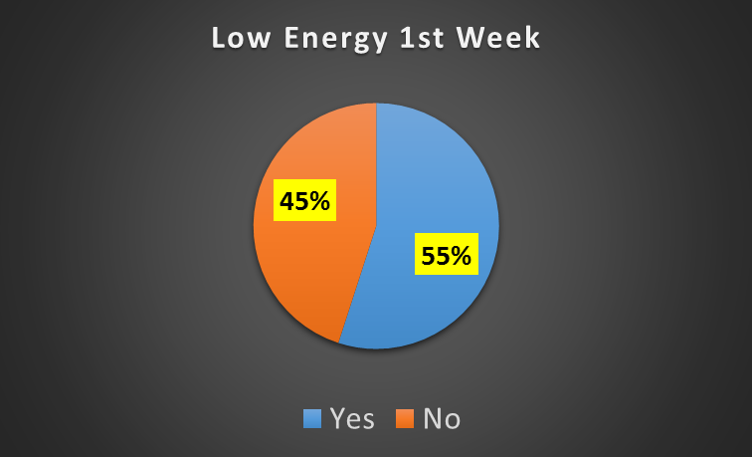
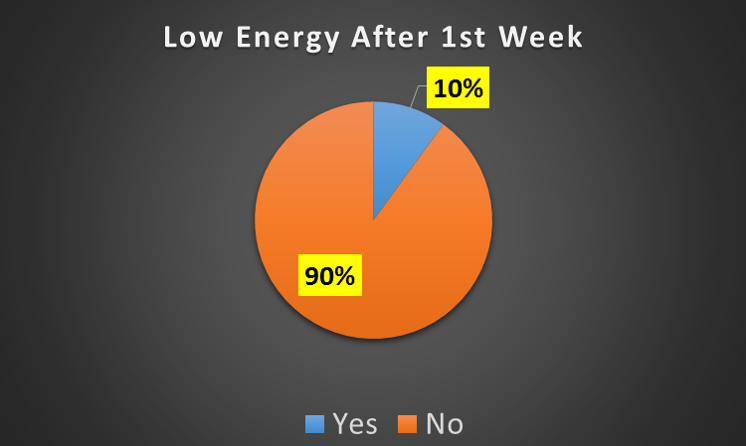
Hormonal Imbalances
Intermittent fasting may sometimes lead to hormonal imbalances, especially in women. As soon as the body senses starvation, it immediately responds by releasing the hormones leptin and ghrelin. These hormones trigger the user to binge on food creating unhealthy food habits.
Prolonged duration of fasting can also affect the sex hormones in females which, in turn, may interfere with normal ovulation. This means that it can have direct effects on fertility.
While the potential for this occurring is there, the probability of such is very small. The women from our survey experienced no hormonal imbalances during the first month.
Intermittent Fasting Results 1 Month Female: Average Daily Water Consumption
Water consumption is very critical to have a good fasting experience. We recommended the women try to drink up to 1
gallon of water per day. Below are the results of the water consumption of the women during the fast.
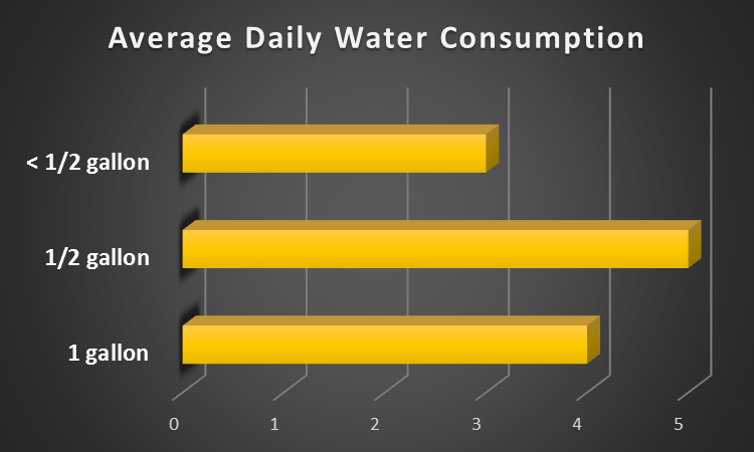
Intermittent Fasting Results 1 Month Female: First Meal After Fast
In our fasting book, we outline the proper way to break a fast to avoid eating and we provide examples of meals to break a fast.
Breaking a fast in the proper way helps to stop binge eating by making
you feel full. Binging after a fast will only stifle your weight loss and increase weight gain. Below is graph showing the first meal the women most frequently ate to end their fast.
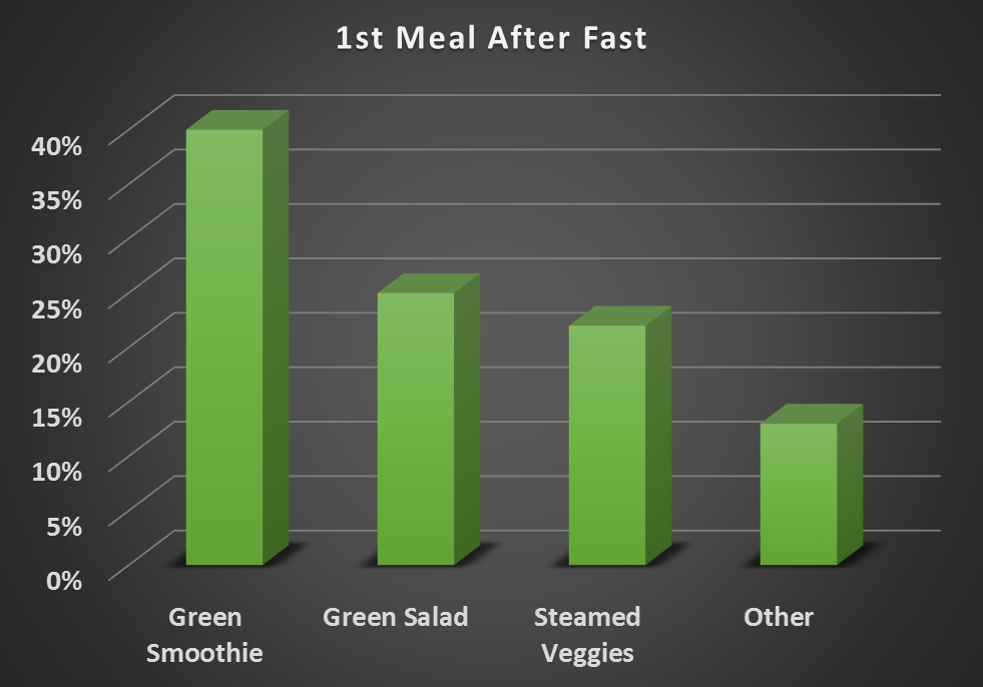
As you can see, most of them had a green smoothie.
More than likely, this is because of the convenience of it. In our intermittent fasting for women ebook, we explain what foods are best to break a fast and we give you great smoothie recipes to break your fast properly, continue fat burning, and avoid binge eating.
Intermittent Fasting Results 1 Month Female: Brain Fog
Initial brain fog is frequently experienced by intermittent fasting practitioners. While intermittent fasting has been scientifically verified to improve brain function, during the beginning stage
of fasting (week 1), people sometime experience brain fog. This condition typically subsides after the first week; however, we asked the women in the group did they experience brain fog during the first week. Fifty-eight percent of them said they did experience brain fog.
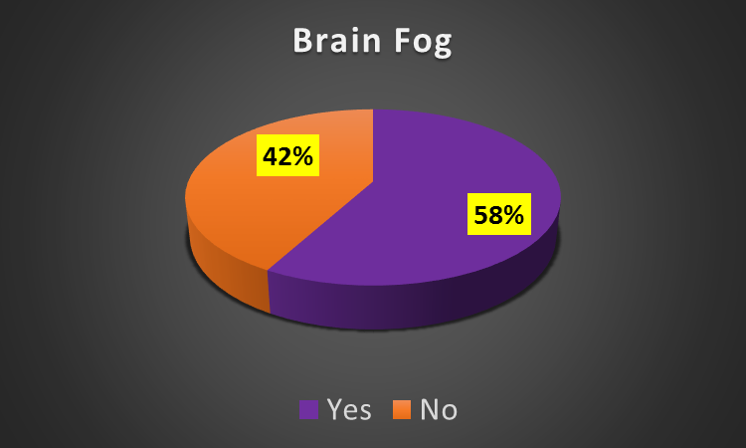
However, it should be noted that all of the women said by the middle of week 2, the brain fog had cleared up.
Intermittent Fasting Results 1 Month Female: Exercise
Exercising for weight loss and overall health is always advised. While it is very possible to lose weight without exercising, to achieve optimal health results, you should. Fifty-eight percent of the women who used the journal and responded to our survey performed routine exercise during the month.
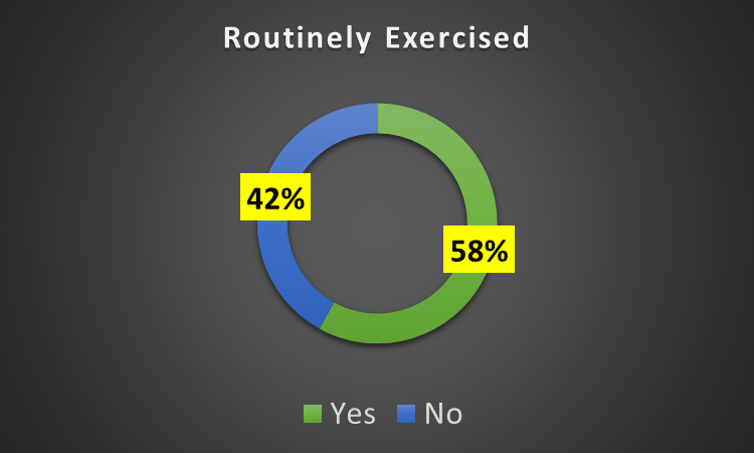
Intermittent fasting is a proven weight loss approach.
If you are ready to experience the same results these women did in their
first month, grab our Intermittent Fasting for Women 60-day Journal on Amazon now. Also, if you send your Amazon number to me (melinda@libifit.com), I’ll
send you a 50% off coupon for our intermittent fasting for women book which answers all of your fasting questions, gives ways to effectively break a fast, and thorough explains all of the health benefits of fasting. It’s normally $9.99, but if you purchase our journal, you can get it for 50% off.

What are you waiting for? These results can be
yours! Get started now and travel down the intermittent fasting road to lose up to 14 pounds in one month and renew your health and vitality!
